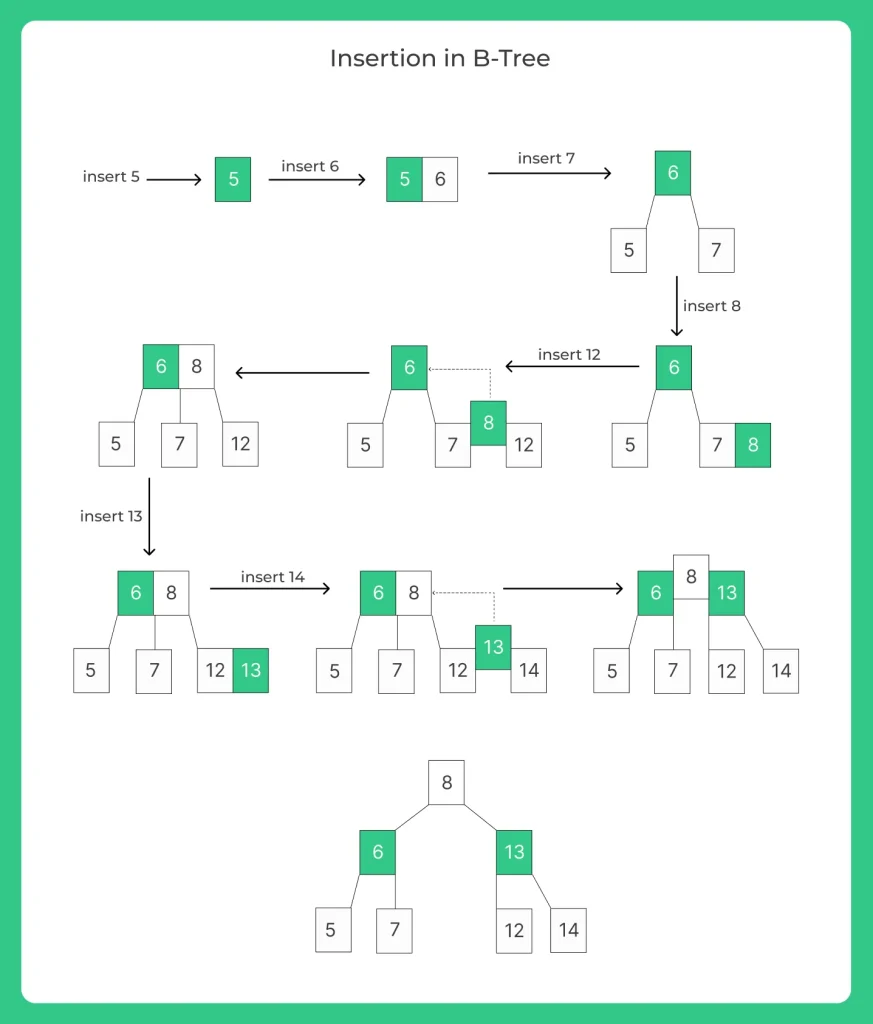Insertion in B-Tree in Java
Insertion in B-Tree
Here, in this section we will discuss Insertion in B-tree in Java. Inserting an element on a B-tree consists of two events : searching the appropriate node to insert the element and splitting the node if required. Insertion operation always takes place in the bottom-up approach. In this article, you will learn how to insert a key into a B-Tree.
B-Tree
B Tree is a specialized m-way tree that can be widely used for disk access. A B-Tree of order m can have at most m-1 keys and m children. One of the main reason of using B tree is its capability to store large number of keys in a single node and large key values by keeping the height of the tree relatively small.
A B tree of order m contains all the properties of an M way tree. In addition, it contains the following properties.
- Every node in a B-Tree contains at most m children.
- Every node in a B-Tree except the root node and the leaf node contain at least m/2 children.
- The root nodes must have at least 2 nodes.
- All leaf nodes must be at the same level.
It is not necessary that, all the nodes contain the same number of children but, each node must have m/2 number of nodes.

Insertion in B-Tree
In a B-Tree, the new element must be added to the leaf node only. The insertion operation can be performed as follows:
- Initially we must check if the tree is empty or not.
- If the tree is found to be empty, then a new node with new key value is created inserted as the root node.
- If the tree is not empty, then using the BST logic the new node is inserted to it’s suitable location.
- If there is some empty location at the leaf then, keeping in mind the increasing order of the key value, the node is inserted at the suitable position.
- If the leaf node is filled completely, then split the node by moving the middle element upwards to the parent node.
- If the node to be split is the root node, then the middle element that is moved becomes the new root node.
A B-tree of order 2 is shown in the following Example:
class BTree
{
private int T;
public class Node
{
int n;
int key[] = new int[2 * T - 1];
Node child[] = new Node[2 * T];
boolean leaf = true;
public int Find (int k)
{
for (int i = 0; i < this.n; i++)
{
if (this.key[i] == k)
{
return i;
}
}
return -1;
};
}
public BTree(int t)
{
T = t;
root = new Node ();
root.n = 0;
root.leaf = true;
}
private Node root;
// split
private void split (Node x, int pos, Node y)
{
Node z = new Node ();
z.leaf = y.leaf;
z.n = T - 1;
for (int j = 0; j < T - 1; j++)
{
z.key[j] = y.key[j + T];
}
if (!y.leaf)
{
for (int j = 0; j < T; j++)
{
z.child[j] = y.child[j + T];
}
}
y.n = T - 1;
for (int j = x.n; j >= pos + 1; j--)
{
x.child[j + 1] = x.child[j];
}
x.child[pos + 1] = z;
for (int j = x.n - 1; j >= pos; j--)
{
x.key[j + 1] = x.key[j];
}
x.key[pos] = y.key[T - 1];
x.n = x.n + 1;
}
// insert key
public void insert (final int key)
{
Node r = root;
if (r.n == 2 * T - 1)
{
Node s = new Node ();
root = s;
s.leaf = false;
s.n = 0;
s.child[0] = r;
split (s, 0, r);
_insert (s, key);
}
else
{
_insert (r, key);
}
}
// insert node
final private void _insert (Node x, int k)
{
if (x.leaf)
{
int i = 0;
for (i = x.n - 1; i >= 0 && k < x.key[i]; i--)
{
x.key[i + 1] = x.key[i];
}
x.key[i + 1] = k;
x.n = x.n + 1;
}
else
{
int i = 0;
for (i = x.n - 1; i >= 0 && k < x.key[i]; i--)
{
};
i++;
Node tmp = x.child[i];
if (tmp.n == 2 * T - 1)
{
split (x, i, tmp);
if (k > x.key[i])
{
i++;
}
}
_insert (x.child[i], k);
}
}
public void display ()
{
display (root);
}
// Display the tree
private void display (Node x)
{
assert (x == null);
for (int i = 0; i < x.n; i++)
{
System.out.print (x.key[i] + " ");
}
if (!x.leaf)
{
for (int i = 0; i < x.n + 1; i++)
{
display (x.child[i]);
}
}
}
}
public class Main{
public static void main (String[]args)
{
BTree b = new BTree(1);
b.insert(5);
b.insert (6);
b.insert (7);
b.insert (8);
b.insert (12);
b.insert (13);
b.insert (14);
b.display ();
}
}
Output :
5 6 7 8 12 13 14
Prime Course Trailer
Related Banners
Get PrepInsta Prime & get Access to all 200+ courses offered by PrepInsta in One Subscription
Get over 200+ course One Subscription
Courses like AI/ML, Cloud Computing, Ethical Hacking, C, C++, Java, Python, DSA (All Languages), Competitive Coding (All Languages), TCS, Infosys, Wipro, Amazon, DBMS, SQL and others
Introduction to Trees
Binary Trees
- Binary Tree in Data Structures (Introduction)
- Tree Traversals: Inorder Postorder Preorder : C | C++ | Java
- Inorder Postorder PreOrder Traversals Examples
- Tree Traversal without Recursion
Binary Search Trees
Traversals
- Traversal in Trees
- Tree Traversals: Breadth-First Search (BFS) : C | C++ | Java
- Tree Traversals: Depth First Search (DFS) : C | C++ | Java
- Construct a Binary Tree from Postorder and Inorder
B – Trees
AVL Trees
- AVL Trees
Complete Programs for Trees
- Depth First Traversals – C | C++ | Java
- Level Order Traversal – C | C++ | Java
- Construct Tree from given Inorder and Preorder traversals – C | C++ | Java
- Construct Tree from given Postorder and Inorder traversals – C | C++ | Java
- Construct Tree from given Postorder and Preorder traversal – C | C++ | Java
- Find size of the Binary tree – C | C++ | Java
- Find the height of binary tree – C | C++ | Java
- Find maximum in binary tree – C | C++ | Java
- Check whether two tree are identical- C| C++| Java
- Spiral Order traversal of Tree- C | C++| Java
- Level Order Traversal Line by Line – C | C++| Java
- Hand shaking lemma and some Impotant Tree Properties.
- Check If binary tree if Foldable or not.- C| C++| Java
- check whether tree is Symmetric – C| C++| Java.
- Check for Children-Sum in Binary Tree- C|C++| Java
- Sum of all nodes in Binary Tree- C | C++ | Java
- Lowest Common Ancestor in Binary Tree- C | C++ | Java
Introduction to Trees
Binary Trees
- Binary Tree in Data Structures (Introduction)
- Tree Traversals: Inorder Postorder Preorder : C | C++ | Java
- Inorder Postorder PreOrder Traversals Examples
- Tree Traversal without Recursion
Binary Search Trees
Traversals
- Traversal in Trees
- Tree Traversals: Breadth-First Search (BFS) : C | C++ | Java
- Tree Traversals: Depth First Search (DFS) : C | C++ | Java
- Construct a Binary Tree from Postorder and Inorder
B – Trees
AVL Trees
- AVL Trees
Complete Programs for Trees
- Depth First Traversals – C | C++ | Java
- Level Order Traversal – C | C++ | Java
- Construct Tree from given Inorder and Preorder traversals – C | C++ | Java
- Construct Tree from given Postorder and Inorder traversals – C | C++ | Java
- Construct Tree from given Postorder and Preorder traversal – C | C++ | Java
- Find size of the Binary tree – C | C++ | Java
- Find the height of binary tree – C | C++ | Java
- Find maximum in binary tree – C | C++ | Java
- Check whether two tree are identical- C| C++| Java
- Spiral Order traversal of Tree- C | C++| Java
- Level Order Traversal LIne by Line – C | C++| Java
- Hand shaking lemma and some Impotant Tree Properties.
- Check If binary tree if Foldable or not.- C| C++| Java
- check whether tree is Symmetric C| C++| Java.
- Check for Children-Sum in Binary Tree- C|C++| Java
- Sum of all nodes in Binary Tree- C | C++ | Java
- Lowest Common Ancestor in Binary Tree. C | C++ | Java






Login/Signup to comment